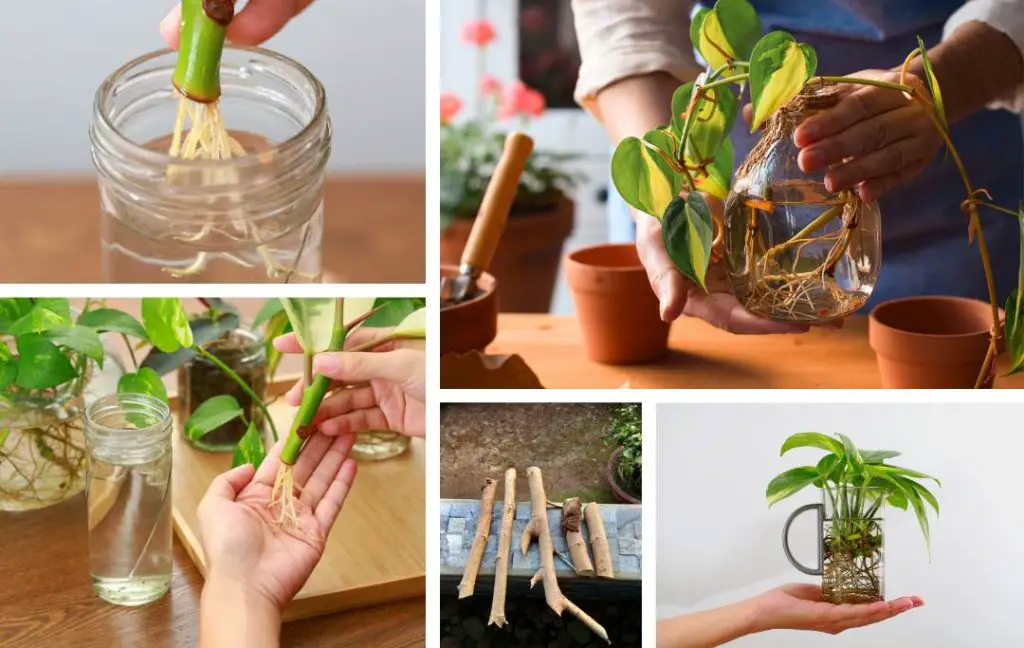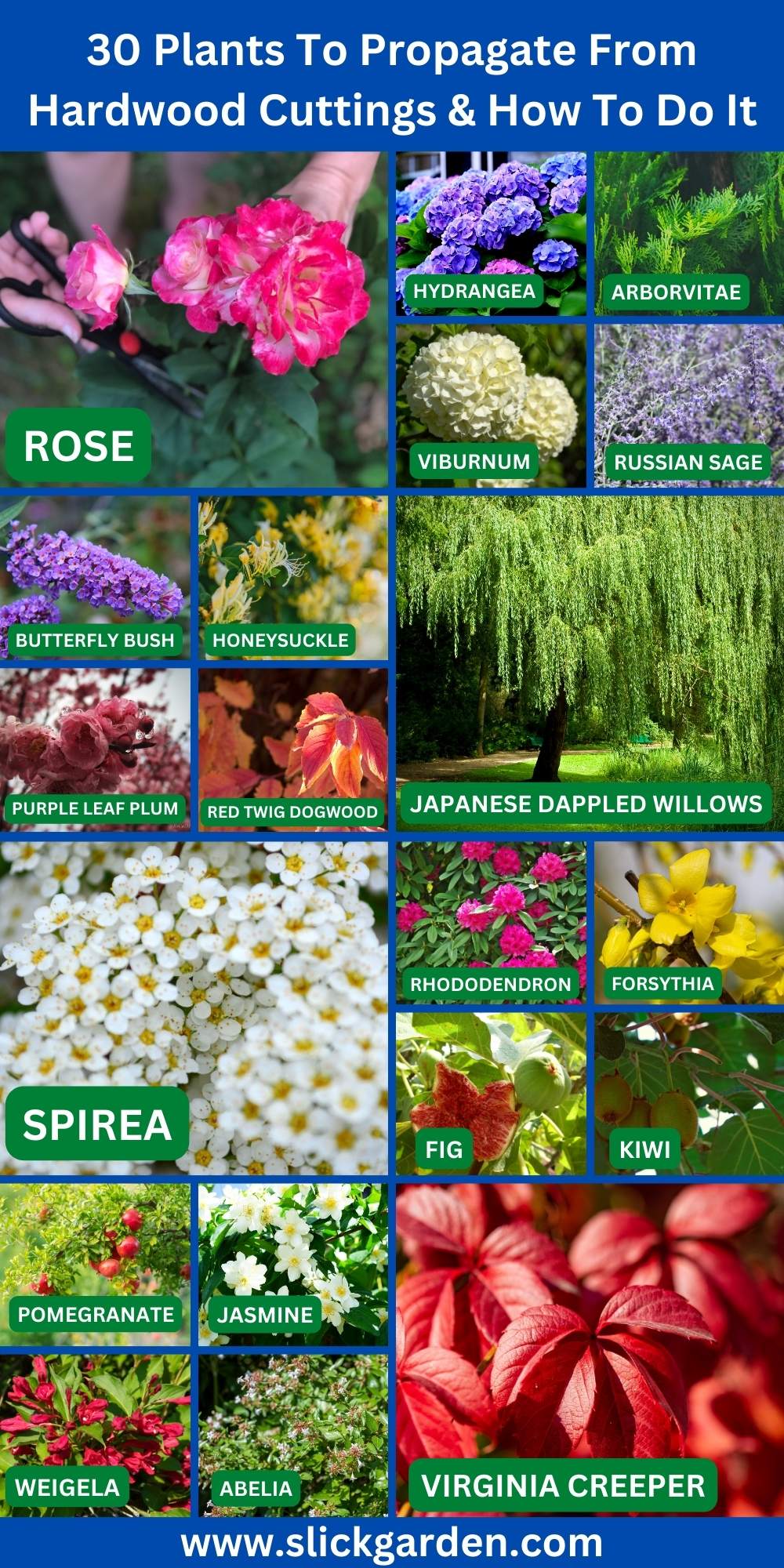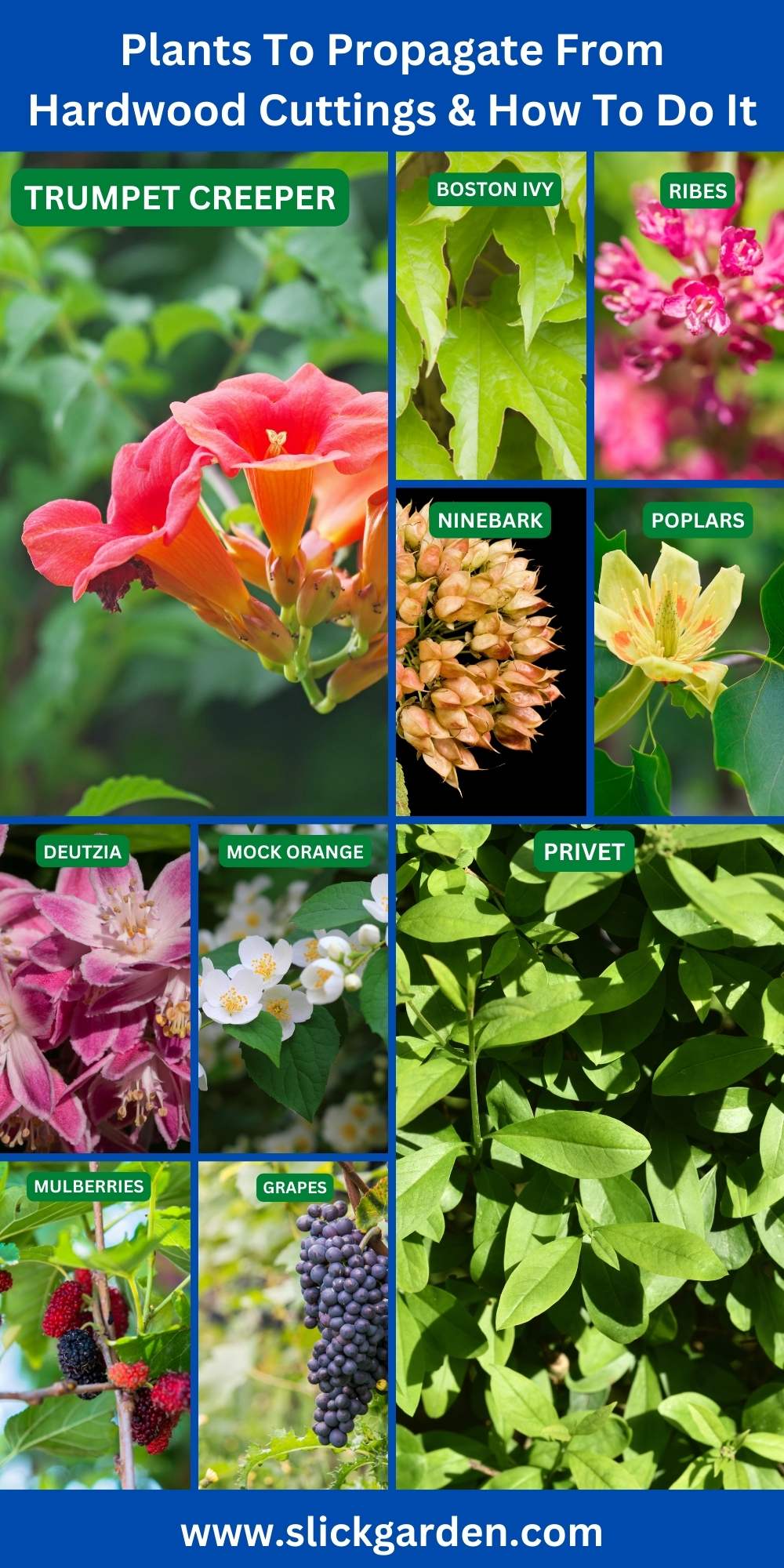You can use hardwood cuttings for propagating purposes. You should take a mature woody branch of a plant in late fall or early spring when the plant is dormant. Hardwood cuttings have no leaves so you have to maintain high-level humidity to prevent the cuttings from drying.

Difference Between Softwood And Hardwood
Following are the differences between hardwood and softwood cuttings.
- You can take softwood cuttings during the growing season. Soft cuttings have leaves but hardwood cuttings don’t. You have to maintain the humidity level of the cuttings and prevent them from drying out so they can develop new roots.
- The ideal time for taking hardwood cutting is in winter or fall. This is a dormancy period for many plants and there are no leaves on these cuttings.
How Do You Take Hardwood Cuttings?
You need a sharp and clean pair of pruners for cutting sections of a woody plant. Make sure the cutting must have at least 3 nodes. Nodes play a very important role in the growth of roots.
When the cutting will start rooting depends upon the variety you choose for growing. You must try a few kinds of cuttings and examine which works best.
- For small branches from your trees and climbers or shrubs.
- Cut the cuttings with the help of sharp pruners.
- Cut off the soft growth tip of the cuttings you must cut at a sloping angle.
- For the best results, it is better to dip the ends of your cuttings in a rooting hormone routing solution to improve the growth results of your hardwood cuttings.
How To Plant Hardwood Cuttings?
- Fill your desired containers or pot with a high-quality potting mix and insert your hardwood cuttings in the soil.
- Water your cuttings so they can easily establish in the new environment.
- If you are living in a cold climate then it is better to place your cuttings in a greenhouse where they are protected from the harsh winter. The hardwood cuttings are dormant in winter months so they need little protection and care.
- Leave the cuttings in the soil till next fall. When spring comes, roots start emerging from the cuttings.
- In the next fall, you can transplant these cuttings to their permanent growing location.
30 Best Plants For Hardwood Cuttings
Following are some plants that can be used to propagate from hardwood cuttings.

1- ROSE
As most plants sleep in the winter so November is the best time to take hardwood cutting from the rose plants. You must select a long straight stem of this year’s new growth.
The stem must be thick just like a pencil. Before planting you should trim the leaves and thorns from the stems. You can also plant this time in the pot but fill your pot with high-quality potting mix for the healthy growth of the new rose plant.
2- HYDRANGEA
It is believed that hydrangeas are perennial flowers but this is wrong because they have woody stems and shrubs. You need properly trimmed hydrangea cuttings and plant them in a potting mix for better results. It is true that hardwood cuttings are slow and challenging to root.
3- ARBORVITAE
When fall comes, the arborvitae plant is in an ideal state for propagation. For better results, you must choose semi-ripe cuttings because they have the energy for rooting.
Greenwood cuttings lose water quickly but hardwood cuttings don’t lose water. After removing the lower leaves of the cuttings you can use rooting hormone to speed up the growth process.
4- VIBURNUM
This is the most versatile and beautiful plant that is used for decorating your garden. Viburnum is a woody plant that’s why its hardwood is used for propagation.
Timing is a very important factor for the propagation of plants through cuttings. It is not easy e to grow plants from hardwood.
5- RUSSIAN SAGE
Hardwood cuttings are the best way of propagating Russian sage in your garden. The ideal time for planting Russian sage from hardwood cutting is in the fall or early winter.
You can multiply your Russian sage plant by using hardwood cuttings. Take the cuttings and dip them in rooting hormone and now they are ready for planting.
Plant them in a small pot or container in the high-quality potting mix, never let the cuttings dry and keep the soil moist. Place your pot or container in sunlight.
6- BUTTERFLY BUSH
This is a bush that produces attractive colors of fragrant flowers such as pink white, purple and yellow. You must plant the cuttings five to six inches deep in the soil of your desired part or container. Make sure you are using a high-quality potting mix that contains all the desired nutrients.
After planting the cuttings they need 6 to 8 hours of sunlight to root. When you see butterfly bush has taken root then this is the right time for planting it in its permanent location in your garden.
7- HONEYSUCKLE
You can take the cuttings of honeysuckle in the morning. Short and lateral stems should be preferred because long stems are soft and not suitable.
They don’t hold excessive moisture for the growth of roots. That’s why they wilt and you will not be successful in your task. The potted cuttings need a warm environment for their growth.
Avoid placing the pot in direct sunlight and you can use a spray bottle to water your cuttings to avoid overwatering. When you see the roots emerging from the cuttings then this is the right time of transplanting it to the permanent location.
8- PURPLE LEAF PLUM
This tree can live for about 20 years and needs maintenance. When your cutting is ready for transplanting then you should prefer rich organic soil. The ideal soil for growing purple-leaf plums must be slightly alkaline.
9- JAPANESE DAPPLED WILLOWS
If you want to root a Japanese tepid below then you only need a branch and stick it in the ground. Water it regularly for the development of new growth.
Your cuttings must be 8 to 12 inches long. If you want fast growth then you should dip cuttings in growth hormone.
10- RED TWIG DOGWOOD
Choose strong stem cuttings from new growth in summer. Now place the cuttings into the gritty moist compost. Keep the soil moist by occasionally watering. You can plant rooted cuttings in autumn.
11- RHODODENDRON
You can grow rhododendron plants from seeds and cuttings. If you don’t have seeds then rooting a cutting is the best way for growing. Remove 4 to 6 leaves near the tip of the hardwood cutting.
Place your cutting in a sanitizing solution for a few seconds. After draining the cuttings, dip them in the rooting hormone to speed up the growth process.
Now plant the cuttings in your prepared pots. When you see the new growth of the cutting then you can plant them in your desired location.
12- FORSYTHIA
Prepare your pot for planting forsythia cuttings. Make sure the pot you are using for growing the cuttings must have drainage holes at the bottom.
Fill your pot with fresh sterile potting soil. Make sure your soil must have perlite and peat. 4 to 8 inches long hardwood cuttings of forsythia plants are ideal for planting.
13- SPIREA
The best time to take hardwood cuttings is in winter. When autumn starts then leaves start dropping. This is an ideal time to take the cuttings from the spirea plant.
Take mature hardwood cuttings and trim them just above the leaf node. Now dig 4 to 6 inches deep holes in the soil. After planting the cuttings in the holes, water them well to maintain the moisture level in the soil.
When you see the new growth, when spring comes then you can plant these cuttings in their permanent location.
14- FIG
Fig is a woody plant that can easily propagate through cuttings. Many varieties of fig root very quickly. The best time for cutting is in winter when the tree is dormant.
These hard cuttings must be 6 to 12 inches long. The diameter of the cuttings must be a half inch. Rooting hormones can speed up the growth process. You can provide a warm environment to your cuttings by wrapping them in a moist paper towel.
Put this paper towel into a plastic bag for a closed humid environment. After two weeks you can plant the cutting in your desired pot. Place your pot in indirect sun and keep the soil moist by regular watering.
Keep Reading:
- 15 Plants That Grow From Cuttings In Water
- What Trees Can Be Grown From Cuttings? 20 Fruit Trees To Grow From Cuttings
15- KIWI
Trim off the bark on the bottom and dip it in the hormone solution. For rooting the cuttings of kiwi you need hormone solution. Now stick these cuttings in the pot that contains the sterilized potting mix.
Leave these cuttings in the pot for at least 60 days. It is better to put this cutting in a greenhouse at a temperature of 70 to 75 degrees Fahrenheit. After 2 months, you can transplant your cuttings into 1 to 3-gallon pots.
When you see your kiwi plant reach a height of 4 feet then this is the right time to transplant them outdoors.
16- POMEGRANATE
You need one-year-old hardwood cuttings for growing a new plant of pomegranate. Take all the cuttings, trim them and place them directly in the pot. After one year you can transplant the newly prepared plant to the permanent location.
17- JASMINE
A successful way of growing Jasmine is through hardwood cuttings. The best time to take hardwood cuttings from the plant is between late autumn and winter. After the leaves drop in the autumn then you can take the cutting
18- WEIGELA
You can propagate weigela in late autumn or winter from hardwood cuttings. This plant needs soil well drained and sandy. You must choose a Sunny location but it can also tolerate partial shade.
When you see new growth in your hardwood cuttings then you can transplant it to the permanent location, before planting you should amend the soil by adding organic matter. Now leave the cuttings in the soil and water them well so they can settle in the new environment.
19- VIRGINIA CREEPER
Growing Virginia Creeper from hardwood cuttings is a straightforward method of propagation. When fall comes then you can take your desired 10 to 12 inches long hardwood cuttings from your plant.
Place the cuttings 6 inches deep in a pot. When winter is over, they start rooting and developing new spring growth. You should remain cutting in the same place until the next fall.
Never let them dry during the summer with regular watering. Now your cutting is ready for transplanting to their permanent location.
20- ABELIA
Make sure the hardwood cuttings you are taking should be from a healthy parent plant. The length of the branch must be 4 to 6 inches. First, clean the cuttings and remove the lower leaves, give the cuttings in the rooting hormone and place it in wet soil.

21- TRUMPET CREEPER
Insert the trumpet vine cuttings into the moist soil. After 1 month you can check the roots. Don’t be discouraged if the rooting process takes some time.
When you plant the prepared cuttings in their permanent location and then install our study support structure it is better to choose a sunny location for trumpet vines.
22- BOSTON IVY
This is a perineal woody wine that is easy to grow. With the help of a sharp knife or pruner, you can take cuttings from healthy-looking stems. Each cutting must have nodes.
23- RIBES
Ribes produce flowers in early spring. You can propagate ribes at two different times of the year. If you choose softwood cuttings then you can take these cuttings in during the growing season. On the other hand, the ideal time for hardwood cuttings is the dormant period of the plant.
24- NINEBARK
This is a beautiful garden shrub that can grow up to 10 feet. A sunny location with a high-quality potting mix will be perfect for growing ninebark in your garden.
25- POPLARS
The interesting thing about poplar trees is that they are hardwood trees and produce rooting hormones. Take hardwood cuttings and place them in a plastic bag in your refrigerator for 2 to 4 weeks.
After that, soak them in a 5-gallon bucket of water for 3 days. After dipping them in rooting hormone, plant the cuttings in loose and well-drained soil.
26- PRIVET
This is a tall and wide plant that can grow from hardwood cuttings. You can create a privacy screen in your garden with this wonderful plant. The leaves of the privet grow closely together.
27- MOCK ORANGE
The mock orange shrub is drought-tolerant and likes to grow in a sunny location. This shrub needs little maintenance and has an amazing fragrance just like orange blossoms.
28- DEUTZIA
This is a beautiful addition to your garden. The bell-shaped flowers have a white color with a pink flush. Remove the lower leaves from the stem. Carefully, plant the cuttings in the soil mix and transplant them in the spring.
29- MULBERRIES
You must choose the best-looking and long enough hardwood cuttings for growing mulberries. The ideal temperature for growing Mulberry plants is 70 to 80 degrees Fahrenheit.
30- GRAPES
The things you need for propagating grape vines are sharp pruning shears, deep pots, potting soil, and your selected hardwood cuttings. Many people use hardwood cuttings for growing grape Vines.
These cuttings can be planted in their permanent location after roots have formed.
Keep Reading:
